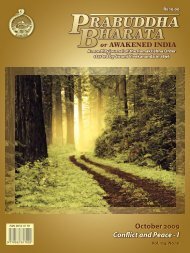According
August 2009 - Advaita Ashrama
August 2009 - Advaita Ashrama
- No tags were found...
Create successful ePaper yourself
Turn your PDF publications into a flip-book with our unique Google optimized e-Paper software.
PB August 2009<br />
Spiritual Substance and Perfection in Indian Thought 39<br />
which is full of pain, is the summum bonum of life,<br />
the highest end. The Sankhya-yogins point out that<br />
even the so-called pleasures of life lead to pain. The<br />
dawn of true knowledge signals kaivalya, liberation,<br />
and is the necessary condition for cessation of all<br />
earthly pain.<br />
Therefore, the Sankhya system neither posits<br />
God as the highest reality nor God-realization as<br />
the goal of life, but it does believe in the self and its<br />
liberation as the ultimate ideal of human life.<br />
Yoga<br />
Yoga delineates the spiritual path leading to kaivalya<br />
through the purification of mind and body. The<br />
word ‘yoga’ ordinarily means ‘union’—the spiritual<br />
union of the individual soul with the universal soul.<br />
This is the sense in which it is used in Vedanta. But<br />
in Patanjali’s system of yoga it is used to denote<br />
samadhi, meditative concentration.<br />
The Bhagavadgita has defined ‘yoga’ as that<br />
state ‘obtaining which one does not think of<br />
any other acquisition as being higher or more<br />
worthy of realization, and being firmly rooted<br />
in which one is not shaken even by the greatest<br />
sorrow’. Yoga is the state beyond all misery and<br />
pain. Patanjali gives a somewhat different meaning<br />
of yoga. To him it means spiritual effort to attain<br />
perfection through the control of the body,<br />
senses, and mind, and right discrimination between<br />
Purusha and Prakriti.<br />
The Yoga philosophy advocates the need for a<br />
healthy mind in a healthy body. For this reason,<br />
purification of mind and body are necessary prerequisites<br />
for perfection. It preaches not emaciation<br />
but perfection of the body. A sound mind needs a<br />
sound body. Therefore passions, which have a disturbing<br />
effect on body and mind, must be mastered<br />
through the path of aṣṭānga yoga. This is the eightfold<br />
path of spiritual discipline, which teaches the<br />
control of body and mind in five steps—yama,<br />
niyama, āsana, prāṇāyāma, pratyāhāra—and then<br />
the focussing of the controlled mind through a further<br />
three advanced steps: dhāraṇā, dhyāna, and<br />
samādhi.<br />
Though this system accepts the reality of God,<br />
his importance lies mainly in being an object of<br />
meditation. He is not the being that creates, sustains,<br />
or destroys the universe. He is not the moral<br />
governor of the universe, nor does he grant liberation.<br />
Nevertheless, Yoga is a path specifically oriented<br />
to spiritual perfection.<br />
Nyaya-Vaisheshika<br />
The Nyaya and Vaisheshika are allied systems that<br />
are both realistic and pluralistic. Nyaya is known<br />
for its logic and epistemology and Vaisheshika for<br />
its atomistic metaphysics. Though these systems accept<br />
God, they do not regard him as the creator of<br />
this universe. God is an eternal substance, coequal<br />
with innumerable atoms and innumerable individual<br />
souls which limit him and distort his glory<br />
and greatness. As Chandradhar Sharma points out,<br />
in the Nyaya-Vaisheshika system God has been reduced<br />
to the status of a supervisor, the first mover<br />
in the process of Creation. The actual process of<br />
Creation unfolds in keeping with the law of karma<br />
or adṛṣṭa, the unseen effects of actions. Liberated<br />
souls do not merge in God nor do they commune<br />
with him. They do not share his knowledge and<br />
bliss. God is also not the moral governor of this<br />
world; he does not reward or punish human actions.<br />
Hence bhakti, devotion, has no place in this<br />
system. There is no internal relation between God,<br />
the human souls, and the world. All relations are<br />
external.<br />
The Nyaya-Vaisheshika concept of self also has<br />
some distinctive features. This system maintains<br />
the plurality of souls—as many souls as there are<br />
bodies—much like the Sankhyas. But consciousness,<br />
according to the Nyaya-Vaisheshikas, is only<br />
an accidental property and not the essence of the<br />
soul. It arises in the soul only in a knowledge situation,<br />
when the soul comes in contact with an external<br />
object of knowledge through the senses and<br />
mind. Further, in the state of moksha, liberation,<br />
the soul is freed from all attributes. This is a negative<br />
concept, for if the soul is a substance, absence<br />
of attributes reduces it to ‘a mere nothing’.<br />
479
















